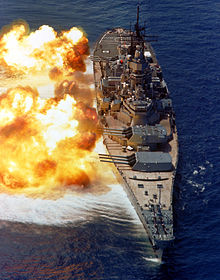
Back بارجة Arabic Acorazáu AST Xətt gəmisi Azerbaijani Лінейны карабель Byelorussian Лінкар BE-X-OLD Линеен кораб Bulgarian ব্যাটেলশিপ Bengali/Bangla Bojni brod BS Cuirassat Catalan Bitevní loď Czech

A battleship is a large, heavily armored warship with a main battery consisting of large-caliber guns, designed to serve as capital ships with the most intense firepower. Before the rise of supercarriers, battleships were among the largest and most formidable weapon systems ever built.
The term battleship came into use in the late 1880s to describe a type of ironclad warship,[1] now referred to by historians as pre-dreadnought battleships. In 1906, the commissioning of HMS Dreadnought into the United Kingdom's Royal Navy heralded a revolution in the field of battleship design. Subsequent battleship designs, influenced by HMS Dreadnought, were referred to as "dreadnoughts", though the term eventually became obsolete as dreadnoughts became the only type of battleship in common use.
Battleships dominated naval warfare in the late 19th and early 20th centuries, and were a symbol of naval dominance and national might, and for decades were a major intimidation factor for power projection in both diplomacy and military strategy.[2] A global arms race in battleship construction began in Europe in the 1890s and culminated at the decisive Battle of Tsushima in 1905,[3][4][5][6] the outcome of which significantly influenced the design of HMS Dreadnought.[7][8][9] The launch of Dreadnought in 1906 commenced a new naval arms race. Three major fleet actions between steel battleships took place: the long-range gunnery duel at the Battle of the Yellow Sea[10] in 1904, the decisive Battle of Tsushima in 1905 (both during the Russo-Japanese War) and the inconclusive Battle of Jutland in 1916, during the First World War. Jutland was the largest naval battle and the only full-scale clash of dreadnoughts of the war, and it was the last major battle in naval history fought primarily by battleships.[11]
The Naval Treaties of the 1920s and 1930s limited the number of battleships, though technical innovation in battleship design continued. Both the Allied and Axis powers built battleships during World War II, though the increasing importance of the aircraft carrier meant that the battleship played a less important role than had been expected in that conflict.
The value of the battleship has been questioned, even during their heyday.[12] There were few of the decisive fleet battles that battleship proponents expected and used to justify the vast resources spent on building battlefleets. Even in spite of their huge firepower and protection, battleships were increasingly vulnerable to much smaller and relatively inexpensive weapons: initially the torpedo and the naval mine, and later attack aircraft and the guided missile.[13] The growing range of naval engagements led to the aircraft carrier replacing the battleship as the leading capital ship during World War II, with the last battleship to be launched being HMS Vanguard in 1944. Four battleships were retained by the United States Navy until the end of the Cold War for fire support purposes and were last used in combat during the Gulf War in 1991, and then struck from the U.S. Naval Vessel Register in the 2000s. Many World War II-era battleships remain today as museum ships.
- ^ Stoll, J. Steaming in the Dark?, Journal of Conflict Resolution Vol. 36 No. 2, June 1992.
- ^ Sondhaus, L. Naval Warfare 1815–1914, ISBN 0-415-21478-5.
- ^ Herwig pp. 35, 41, 42.
- ^ Mahan 1890/Dover 1987 pp. 2, 3.
- ^ Preston 1982, p. 24.
- ^ Corbett (2015) Vol. II, pp. 332, 333, "So was consummated perhaps the most decisive and complete naval victory in history"
- ^ Breyer p. 115.
- ^ Massie (1991) p. 471.
- ^ Friedman (2013) p. 68, Captain Pakenham, British observer at Tsushima; "...When 12 inch guns are firing, 10 inch guns go unnoticed...Everything in this war has tended to emphasise the vast importance to a ship...of carrying some of the heaviest and furthest-shooting guns that can be got into her."
- ^ Corbett (2015) Vol. 1, pp. 380, 381; the Russians turned back after Admiral Vitgeft was killed aboard his flagship, the battleship Tzesarevich; to remain bottled up in Port Arthur, pending arrival of the Russian Baltic Fleet in 1905. Known as the Battle of August 10 in Russia.
- ^ Jeremy Black, "Jutland's Place in History", Naval History (June 2016) 30#3 pp. 16–21.
- ^ O'Connell, Robert J. (1993). Sacred vessels: the cult of the battleship and the rise of the U.S. Navy. Oxford [Oxfordshire]: Oxford University Press. ISBN 978-0-19-508006-3. [page needed]
- ^ Lenton, H. T.: Krigsfartyg efter 1860
© MMXXIII Rich X Search. We shall prevail. All rights reserved. Rich X Search